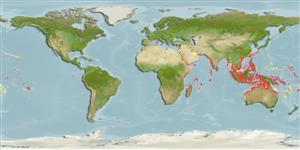Common names from other countries
>
Clupeiformes (Herrings) >
Engraulidae (Anchovies) > Engraulinae
Etymology: Stolephorus: Greek, stole, -es = garment + Greek, pherein = to carry (Ref. 45335).
Issue
Information by locality and reference are being linked to respective valid species: balinensis, belaerius, commersonnii, scitulius (Ref. 123745).
Environment: milieu / climate zone / depth range / distribution range
экология
морской; солоноватоводный; мигрирует в океане; пределы глубины 20 - 50 m (Ref. 28016). Tropical; 30°N - 37°S, 23°E - 144°W (Ref. 189)
Indian Ocean: from the Red Sea to Ranong and Phuket, Thailand.
Length at first maturity / Size / Вес / Возраст
Maturity: Lm 9.0, range 12 - ? cm
Max length : 15.5 cm SL самец/пол неопределен; (Ref. 30573); common length : 12.0 cm SL самец/пол неопределен; (Ref. 30573)
колючие лучи спинного плавника (общее число) : 0; членистые (мягкие) лучи спинного плавника (общее число) : 15 - 17; колючие лучи анального плавника: 0; членистые (мягкие) лучи анального плавника: 19 - 21. Diagnosis: Body slender, elongate, rather round in cross-section, belly rounded, with 2-6 small needle-like pre-pelvic scutes; maxilla tip pointed, reaching to or only just beyond front border of pre-operculum; hind border of pre-operculum convex, rounded; lower gillrakers 20-28; isthmus muscle tapering evenly forward to hind border of branchial membrane; pelvic fin tips not reaching to below dorsal fin origin; anal fin short, with usually 3 unbranched and 16-18 branched finrays, its origin below centre of dorsal fin base; body light transparent fleshy brown, with a silver stripe down flank; no dark pigment lines on back between head and dorsal fin (Ref. 189). Other species with such a short maxilla are Stolephorus advenus, with 7 pre-pelvic scutes, and S. pacificus, with 35-38 gillrakers; maxilla to or almost to hind border of pre-operculum in other Stolephorus species (Ref. 189).
A schooling species occurring in coastal waters and which appears to enter at least the estuarine parts of rivers and to tolerate brackish water. Coastal pelagic (Ref. 68964). Feeds most likely on zooplankton, but more data needed. Used as bait in the tuna fishery in the South Pacific, although said to be fragile. Also Ref. 58652.
In Manila Bay, migrates out into deeper and more saline water to breed (at about 9 cm SL and above), returning immediately thereafter.
Hata, H., S. Lavoué and H. Motomura, 2021. Taxonomic status of nominal species of the anchovy genus Stolephorus previously regarded as synonyms of Stolephorus commersonnii Lacepède 1803 and Stolephorus indicus (van Hasselt 1823), and descriptions of three new species (Clupeiformes: Engraulidae). Ichthyol. Res. 68(3):327-372. (Ref. 123745)
Статус Красного Списка МСОП (Ref. 130435)
CITES (Ref. 128078)
Not Evaluated
Угроза для людей
Harmless
Использование человеком
рыболовство: коммерческий; наживка: occasionally
дополнительная информация
инструменты
Специальные отчеты
Скачать в формате XML
ресурсы в Интернет
Estimates based on models
Preferred temperature (Ref.
115969): 24.2 - 28.7, mean 27.9 (based on 362 cells).
Phylogenetic diversity index (Ref.
82804): PD
50 = 0.5000 [Uniqueness, from 0.5 = low to 2.0 = high].
Bayesian length-weight: a=0.00537 (0.00454 - 0.00635), b=3.14 (3.09 - 3.19), in cm Total Length, based on LWR estimates for this species (Ref.
93245).
Trophic level (Ref.
69278): 3.6 ±0.0 se; based on diet studies.
устойчивость к внешним воздействиям (Ref.
120179): высокий, минимальное время удвоения популяции до 15 месяцев (K=0.71-1.42).
Fishing Vulnerability (Ref.
59153): Low vulnerability (13 of 100).
